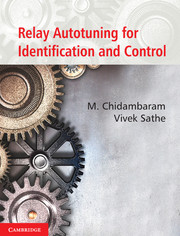Book contents
- Frontmatter
- Contents
- List of Figures
- List of Tables
- Acknowledgements
- Preface
- 1 Introduction
- 2 Improved Autotune Identification Methods
- 3 Cascade Controllers Tuning by Relay Autotune Method
- 4 Simultaneous Relay Autotuning of Cascade Controllers
- 5 A Simple Method of Tuning Cascade Controllers
- 6 Improved Saturation Relay Test for Systems with Large Dead Time
- 7 Identification of FOPTD Model using Single Symmetrical Relay Test
- 8 Autotuning of PID Controllers for Unstable FOPTD Systems
- 9 Autotuning of PID Controllers for Critically Damped SOPTD Systems
- 10 Estimation of SOPTD Transfer Function Model
- 11 Estimation of Five Parameters of Unstable SOPTD Model with a Zero
- 12 Identification of FOPTD Multivariable Systems
- 13 Identification of SOPTD Multivariable Systems
- 14 Tuning of Multivariable Controllers for Non-Minimum Phase Systems
- 15 Tuning of Multivariable Controllers by Genetic Algorithms
- 16 Summary and Conclusions
- Appendix A
- Appendix B
- Appendix C
- Nomenclature
- Problems
- Suggestive Reading
- References
- Index
12 - Identification of FOPTD Multivariable Systems
Published online by Cambridge University Press: 05 June 2014
- Frontmatter
- Contents
- List of Figures
- List of Tables
- Acknowledgements
- Preface
- 1 Introduction
- 2 Improved Autotune Identification Methods
- 3 Cascade Controllers Tuning by Relay Autotune Method
- 4 Simultaneous Relay Autotuning of Cascade Controllers
- 5 A Simple Method of Tuning Cascade Controllers
- 6 Improved Saturation Relay Test for Systems with Large Dead Time
- 7 Identification of FOPTD Model using Single Symmetrical Relay Test
- 8 Autotuning of PID Controllers for Unstable FOPTD Systems
- 9 Autotuning of PID Controllers for Critically Damped SOPTD Systems
- 10 Estimation of SOPTD Transfer Function Model
- 11 Estimation of Five Parameters of Unstable SOPTD Model with a Zero
- 12 Identification of FOPTD Multivariable Systems
- 13 Identification of SOPTD Multivariable Systems
- 14 Tuning of Multivariable Controllers for Non-Minimum Phase Systems
- 15 Tuning of Multivariable Controllers by Genetic Algorithms
- 16 Summary and Conclusions
- Appendix A
- Appendix B
- Appendix C
- Nomenclature
- Problems
- Suggestive Reading
- References
- Index
Summary
In this chapter, a technique for identification of multivariable transfer function matrix proposed by Ganesh and Chidambaram (2003) is reviewed. They extended the method of Srinivasan and Chidambaram (2003) meant for asymmetric relay feedback for a scalar system to a multivariable system. The method identifies the FOPTD model for each element of the transfer function matrix model without any priori knowledge of the value of time delay or gain of the system. In this method, a decentralized relay feedback method suggested by Wang et al. (1997) is applied to the m × m system and ‘m’ relay feedback tests are required for identifying the entire transfer function matrix. The identification method is a closed loop relay feedback method and hence this method is less susceptible to disturbance and measurement noise and can be used for identifying an unstable system. The method is applied for various 2 × 2 transfer function matrices as Wood and Berry's methanol-water distillation column process (1973) and a multivariable system with higher order individual elements. IMC controller (Tanttu and Lieslehto, 1991) is designed for the identified model, and using this controller the closed loop performances of actual and identified models are compared.
Introduction
The transfer function model of the system is required for designing a suitable control system. The dynamic models of process are determined from the fundamental physical and chemical laws. But for the process that is already in operation, there is an alternative approach based on experimental dynamic data obtained from plant test.
- Type
- Chapter
- Information
- Relay Autotuning for Identification and Control , pp. 165 - 173Publisher: Cambridge University PressPrint publication year: 2014



